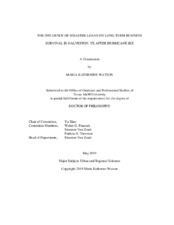| dc.contributor.advisor | Xiao, Yu | |
| dc.creator | Watson, Maria Katherine | |
| dc.date.accessioned | 2020-04-23T16:12:12Z | |
| dc.date.available | 2021-05-01T12:36:05Z | |
| dc.date.created | 2019-05 | |
| dc.date.issued | 2019-04-19 | |
| dc.date.submitted | May 2019 | |
| dc.identifier.uri | https://hdl.handle.net/1969.1/187915 | |
| dc.description.abstract | The U.S. Federal Government has taken an increasingly active role in disaster relief efforts, yet program analyses of the efficacy of Federal recovery programs— particularly for businesses—is limited. This dissertation fills the gap by exploring the effects of Federal disaster loans on long-term business post-disaster recovery outcomes. Using the case of the U.S. Small Business Administration (SBA) Disaster Loan Program in Galveston County Texas after 2008 Hurricane Ike, this research examines which businesses benefit from Federal assistance and whether loans improved odds of survival for businesses nine years after Hurricane Ike. This dissertation contributes to the body of work on disaster assistance programs and business recovery through new methodological and theoretical approaches to these questions. This research is grounded in institutional theory, namely institutional logics and resource dependence, and uses quasi-experimental design to tease out the effect of the loan program from potential confounding factors that affect business survival. This research uses a combination of primary data collected directly from the field and secondary data, such as business information reported by ReferenceUSA, sales tax and franchise tax permit information from the Texas State Comptroller, and data provided by the SBA through Freedom of Information Act requests. Coarsened Exact Matching is used to match businesses that received a loan (treatment sample) to businesses without a loan but otherwise similar in damage and firm characteristics (matched sample). For the matched sample, conditional logistic regression is used to analyze the effect of disaster loans on survival. For the treatment-only sample, linear regression and logistic regression are used to examine determinants of loan amount and which businesses are more likely to utilize the loans. This research found that businesses that received a loan had higher odds of survival compared to their control, however businesses differed in the amount of money their received and likelihood of accepting the loan based on their damage, their characteristics, and the characteristics of the loan, itself. This research concludes with suggestions of how disaster policy aimed at businesses might be improved, as well as how planners might fill potential gaps in recovery left by the SBA loan program. | en |
| dc.format.mimetype | application/pdf | |
| dc.language.iso | en | |
| dc.subject | Business Recovery | en |
| dc.subject | Quasi-Experimental Design | en |
| dc.subject | Institutional Logics | en |
| dc.subject | Institutional Theory | en |
| dc.subject | Policy Analysis | en |
| dc.subject | Disaster Recovery | en |
| dc.title | The Influence of Disaster Loans on Long-Term Business Survival in Galveston, TX after Hurricane Ike | en |
| dc.type | Thesis | en |
| thesis.degree.department | Landscape Architecture and Urban Planning | en |
| thesis.degree.discipline | Urban and Regional Science | en |
| thesis.degree.grantor | Texas A&M University | en |
| thesis.degree.name | Doctor of Philosophy | en |
| thesis.degree.level | Doctoral | en |
| dc.contributor.committeeMember | Peacock, Walter G. | |
| dc.contributor.committeeMember | Van Zandt, Shannon | |
| dc.contributor.committeeMember | Thornton, Patricia H. | |
| dc.type.material | text | en |
| dc.date.updated | 2020-04-23T16:12:13Z | |
| local.embargo.terms | 2021-05-01 | |
| local.etdauthor.orcid | 0000-0002-6392-5081 | |


